Term 3 Unit 2 | Civics | 6th Social Science - Local Bodies - Rural and Urban | 6th Social Science : Civics : Term 3 Unit 2 : Local Bodies - Rural and Urban
Chapter: 6th Social Science : Civics : Term 3 Unit 2 : Local Bodies - Rural and Urban
Local Bodies - Rural and Urban
Unit 2
LOCAL BODIES – RURAL AND URBAN
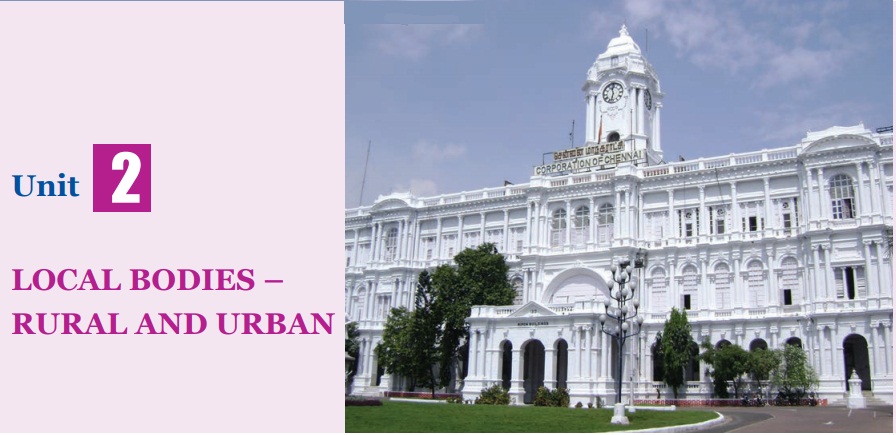
Learning Objectives
*
To know about the structure and functions of rural and urban local bodies.
*
To know about the Grama Sabha and the purpose of Grama Sabha meeting.
*
To understand the special features of Panchayatraj.
*
To know about the participation of women in local bodies.
*
To know about the election of local body and will observe the forthcoming
election.
Nandhini
is in standard VI. It was her custom to read the headlines in the newspaper
loudly to her parents Mr. Namburajan and Mrs. Manimegalai. They would clear her
doubts. Sometimes, children from their neighbourhood would also join her and
each one will read an article loudly. As it was a Saturday, Johnson, Maran and
Anwar were also in Nandhini’s house. Nandhini started to read an article from
the newspaper.
“Nagercoil
Municipality to become corporation soon”
She was about to
read the next heading, but she had a doubt and asked her father.
“Father, what is a
corporation?”
“The Government of
Tamil Nadu will declare certain municipalities based on population and high
revenue. That’s how Nagercoil has to be declared as a corporation too”, said
her father Namburajan.
“Oh, if that is so,
are there other corporations that exist already?”
“Yes, there are
twelve corporations in Tamil Nadu”, said Namburajan.
The List of corporations in Tamil Nadu
1. Chennai
2. Madurai
3. Coimbatore
4. Tiruchirapalli
5. Salem
6. Tirunelveli
7. Erode
8. Thoothukudi
9. Tiruppur
10. Vellore
11. Dindigul
12. Thanjavur
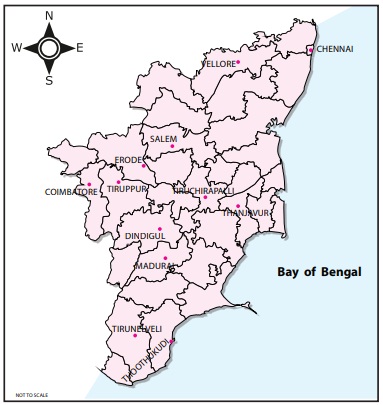
The Chennai Corporation which was
founded in 1688 is the oldest local body in India.
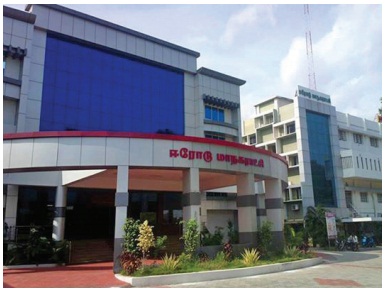
“Father, what about
the place we live in” enquired Maran.
“We live in a
Panchayat, Maran”.
“What is a
Panchayat?”
“There are villages
as well as cities in Tamil Nadu, aren’t there?”
“Yes, father”.
“Won’t the needs of
villages and cities differ? Our constitution has provided certain structures to
fulfill the needs of the people.
Accordingly, the
urban local bodies are categorized into City Minicipal Corporations,
Municipalities and Town Panchayats, while the rural local bodies are
categorised into Village Panchayats, Panchayat Unions and District Panchyats.
These are together known as local bodies.”
“Oh, are there so
many divisions?”
“Yes, I’ll tell you
about them. Didn’t I tell you about the City Municipal Corporations?”
“Yes, father”.
“Those areas which
have a population of more than one lakh and a high amount of revenue and is
found in the level below the City Municipal Corporation is called a Municipality.
•
Walajahpet Municipality
(Vellore District) is the first Municipality in Tamil Nadu.
• Kanchipuram District has the most number of municipalities.
“You mentioned
something about towns”.
“A Town Panchayat
has about 10,000 population. A Town Panchayat is between a village and a
city.
There is something
special about the Town Panchayat. Can anyone tell me what is it?”, asked
Namburajan. Everyone was gazing at him. But none answered.
“Well, I’ll tell
the answer myself.
Tamil Nadu was the first state to introduce a town
Panchayat in the whole of India”.
All were amazed on
hearing it.
A City Municipal
Corporation has a Commissioner, who is an Indian Administrative
Service (IAS) officer. Government officials are deputed as Commissioners for
the municipalities. The administrative officer of a Municipality is an Executive
Officer (EO).
“You mentioned
about Panchayats and Panchayat Unions”.
The Village
Panchayats are the local bodies of villages. They act as a link between the
people and the government. Villages are divided into wards based on their
population. The representatives are elected by the people.
The
Elected Representatives
1. Panchayat
President
2. Ward members
3. Councillor
4. District Panchayat Ward Councillor

Panchayat
Union.
Many village
Panchayats join to form a Panchayat Union. A Councillor is
elected from each Panchayat, isn’t it? Those councillors will elect a
Panchayat Union Chairperson among themselves. A Vice Chairperson
is
also elected. A Block Development Officer
(BDO) is the administrative head, of a Panchayat Union.
The services are
provided on the Panchayat Union level.
Villupuram District has the highest number of Panchayat Unions (22), while The
Nilgiris and Perambalur Districts have the lowest number (4).
District Panchayat
A District
Panchayat is formed in every district. A district is divided into wards on the
basis of 50,000 population. The ward members are elected by the Village
Panchayats. The members of the District Panchayat elect the District
Panchayat Committee Chairperson. They provide essential
services and facilities to the rural population and the planning and execution
of development programmes for the district.
The local bodies
are governed by the representatives elected by the people. The constituencies
are called wards. People elect their ward members.
The Mayor of the City Municipal Corporation and
the Municipal Chairperson are the elected representatives of the people.
The people elect them. The Corporation Deputy Mayor and the Municipal
Vice Chairperson are elected by the ward councillors” finished
Namburajan.
“What are the
benefits of local bodies, uncle?”
“There are many
benefits. The services provided can be divided as obligatory functions and
discretionary functions. These are provided by the local bodies.
Functions of the village Panchayat
Obligatory
Functions
* Water supply
* Street lighting
* Cleaning
roads
* Drainage
& sewage pipes system
* Laying down
roads
* Activation
of Central and State Government schemes
Discretionary
Functions
* parks
* Libraries
* Playgrounds,
etc.
Functions of the City Municipal
Corporation
* Drinking
water supply
* Street
Lighting
* Maintenance
of Clean Environment
* Primary
Health Facilities
* Laying of
Roads
* Building
flyovers
* Space for
markets
* Drainage
System
* Solid waste
management
* Corporation
schools
* Parks
* Play grounds
* Birth and
Death registration, etc. “So, who does all these works?”
“As per the
decisions taken in the city Hall meetings, the commissioner or officers assign these works to their subordinate
officers or other servants. Thus, they all work in various levels to get these
public works done”.
“Will the
Government provide funds for these services, father?”
“The
Government directly allots funds for these works. The local bodies also collect
revenue”.
Revenue of the Village Panchayat
* House tax
* Professional
tax
* Tax on shops
* Water
charges
* Specific
fees for property tax
* Specific
fees for transfer of immovable property
* Funds from
Central and State Governments, etc.
Revenue of the City Municipal
Corporation
* House Tax
* Water Tax
* Tax on
shopping complexes
* Professional
Tax
* Entertainment
Tax
* Vehicle
Charges
* Funds by
Central and State Government, etc.
Activity
•
Distinguish between rural and urban revenue and functions.
•
Find out from your home: The taxes paid by your family.
“How are the
Grama Sabha meetings held, uncle?” asked Maran.
“Grama Sabha
meetings? In movies, I have seen elders sitting under trees and discussing
important matters and take decisions,” said Johnson.
“No, no, both
are different. A Grama Sabha is formed in every Village Panchayat. It is the only
permanent unit in the Panchayat Raj System. Grama Sabha meetings are held even
in smaller villages. The Grama Sabha is the grass root level democratic
institution in a Village Panchayat”.
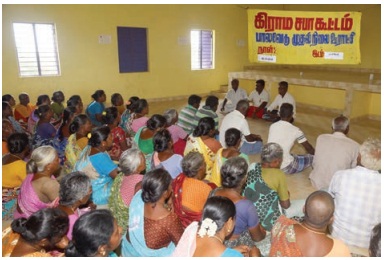
Those who have
attained the age of 18 years and whose names are found in the electoral roll of
the same Panchayat can take part in a Grama Sabha meeting. The Grama Sabha
meetings are conducted four times a year. Officers like the District Collector,
the Block Development Officer, teachers etc., also participate in this meeting.
The people can freely express their needs and grievances”.
When are these
meetings convened?
January 26, May 1, August 15 and
October 2.
Apart from
these days, the meetings can be convened as per need or during emergency.
These are
called Special Grama Sabha meetings.
Activity
The
teacher guides the student to visit the Grama Sabha meeting.
“Mahatma
Gandhi advocated Panchayat Raj as the foundation of India’s political system,
as a form of government, where each village would be responsible for its own
affairs. The Panchayat Raj Act was enacted on April 24, 1992”.
April
24 is National
Panchayat Raj Day.
Special features of Panchayat Raj
* Grama Sabha
* Three tier
local body governance
* Reservations
* Panchayat
Elections
* Tenure
* Finance
Commission
* Account and
Audit, etc
“Thank you very
much, uncle. We really learnt a lot about local bodies”, said the children
gratefully.
“I’m very happy
that I could share so much with you today. That’s enough of reading newspapers.
Go out and play now”, said Namburajan.
The children
ran out to play joyously.
Activity
The
Central Government gives awards to the best performing Village Panchayats. Find
out if your village has received such awards.
Role of women in the Local Self
Government
All local
bodies have a reservation of 33% for women. In the 2011 Local Bodies election,
38% seats were won by women. As per the Tamil Nadu Panchayats(Amendment) Act,
2016, 50% reservation for women is being fixed in Panchayat Raj institutions.
Activity
Find
out about the ward members of your area. Talk to the women members and discuss
about their participation and experiences.
Local Body Election
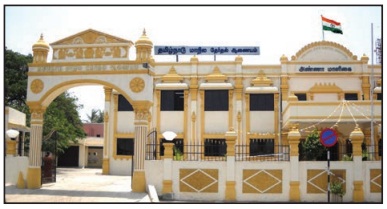
The tenure for
the representatives of local self Government is 5 years. The election to the
Local Bodies is held once in five years by the State Election Commission. Every
state has a State Election Commission. The Tamil Nadu State Election Commission
is situated in Koyambedu, Chennai.
Tamil Nadu
Village Panchayats
- 12,524
Panchayat
Unions - 385
District
Panchayats - 31
Town
Panchayats - 561
Municipalities
- 125
City Municipal
Corporations – 12
Think it over
Do
you think the above numbers are stable? Find out about the recent changes.
What
is the number of votes cast by rural and urban voters in a local body election?
HOTS
Why are there only 31 district panchayats, but 32 districts?
Works carried out by local bodies durings
natural disasters and out break of diseases.
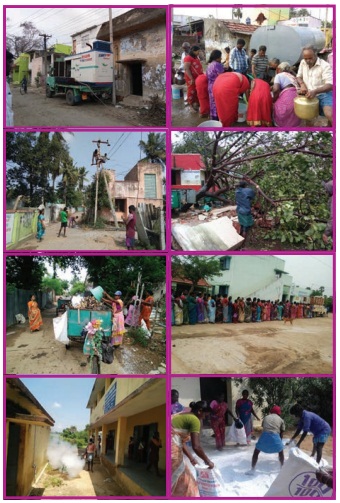
GLOSSARY
1. Corporation - மாநகராட்சி
2. Municipality - நகராட்சி
3. Town Panchayat - பேரூராட்சி
4. Village Panchayat - கிராம ஊராட்சி
5. Panchayat Union - ஊராட்சி ஒன்றியம்
RECAP
* Local bodies
are structures to fulfill the needs of people.
* Panchayat,
Panchayat Union and District Panchayat are rural local bodies.
* Town
Panchayat, Municipality and Corporation are urban local bodies.
* Grama Sabha
is the only permanent unit in a village Panchayat.
* Panchayat
Raj System strengthened the local bodies.
* The election
of local bodies take place in every five years.
ICT CORNER
Civics - Local body
Through this
activity you will k aboutthe local
body structure of India.
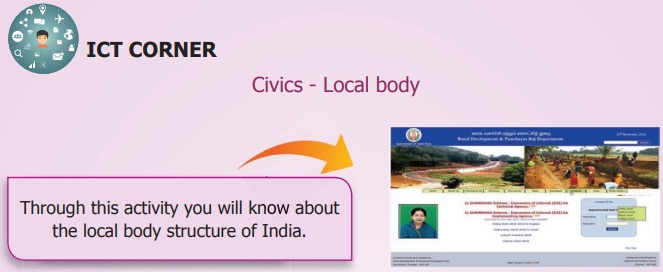
Steps:
Step 1: Use the URL or scan the QR code to open the
activity page.
Step 2: Click the “panchayat Raj” to know about
panchayat rules and acts.
Step 3: Click
the “Scheme” to know about state and central schemes of panchayat raj.
Step 4: Click the “map” option to know how many
panchayat raj in tamilnadu.
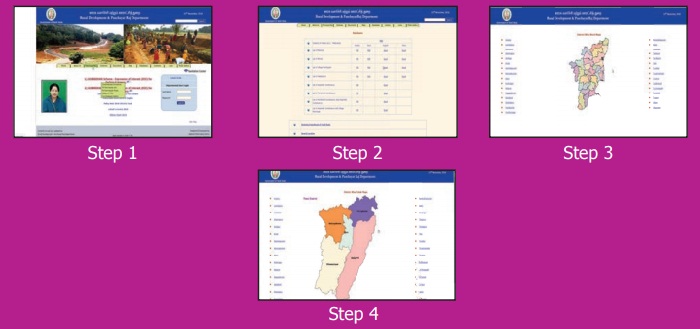
*Pictures are indicatives only.
Browse in the link
Web: https://www.tnrd.gov.in/index.html
(or) scan the QR Code
Related Topics